After being put into lockdown for 76 days, Wuhan, the former epicenter of the novel coronavirus outbreak in China, is finally reconnected with the rest of the world. Bans on outbound traffic were officially lifted in the city at midnight Tuesday, ending the long-lasting sacrifice -- the strictest ever measures to curb an epidemic in modern human history.
by Xinhua writers Ma Yujie, Yue Wenwan, Yu Pei and Wang Zuokui
WUHAN, April 8 (Xinhua) -- Wearing a mask and gloves, captain Mao Lin finally returned to his familiar cockpit after 76 days of grounding.
Looking at the dashboard and joystick, he felt a surge of emotion and began his long-prepared broadcast.
"Dear passengers, this is your captain speaking. I am very honored to accompany you from Wuhan to our long-lost dream and destination."
His flight was the first passenger plane taking off from Wuhan at 7:22 a.m. Wednesday since the city closed itself on Jan 23.
After being put into lockdown for almost 11 weeks, Wuhan, the former epicenter of the novel coronavirus outbreak in China, is finally reconnected with the rest of the world.
Bans on outbound traffic were officially lifted in the city at midnight Tuesday, ending the long-lasting sacrifice -- the strictest ever measures to curb an epidemic in modern human history.
"I'm very happy to see the lockdown lifted. The reopening of outbound traffic shows the epidemic situation has improved, and our hard work over the past two months has paid off," said Fang Jing, a staff member of an expressway toll station in Wuhan.
Wuhan Tianhe International Airport is expected to see more than 220 inbound and outbound flights on Wednesday, according to the airport.
More than 55,000 passengers are expected to take trains to leave Wuhan on Wednesday, with about 40 percent heading for the Pearl River Delta region. A total of 276 passenger trains will leave Wuhan for economic hubs like Shanghai, Shenzhen and other cities.
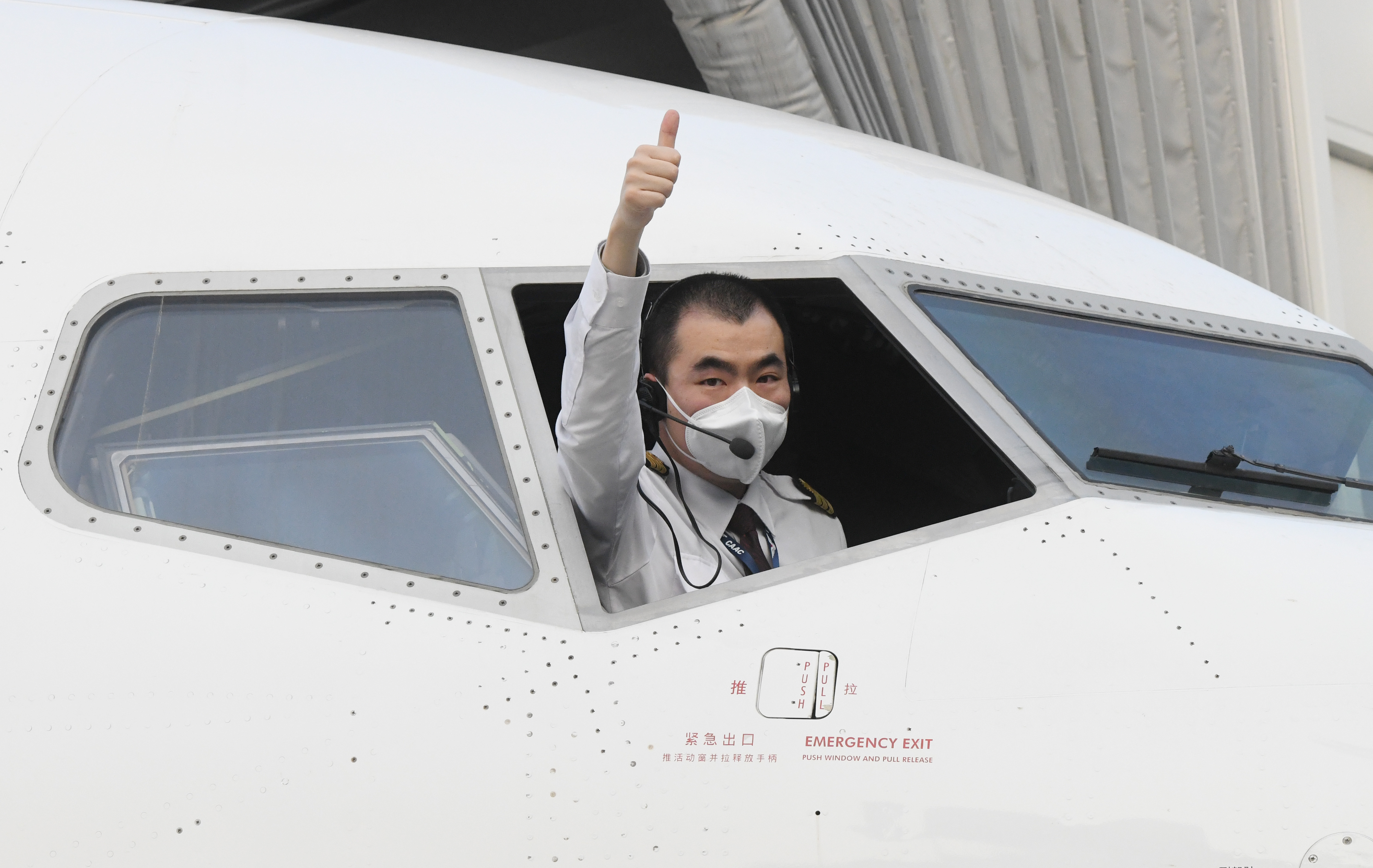
Copilot Yang Yang of flight MU2527 of China Eastern airlines gestures before takeoff at the Tianhe International Airport in Wuhan, central China's Hubei Province, April 8, 2020. (Xinhua/Cheng Min)
With expressway barricades removed, trains departing and planes taking off, Xie Pinghua knows his yearning to leave Wuhan and reunite with his family will soon come true.
He was on a train heading to Wuhan, the provincial capital of Hubei Province, when the megacity closed all outbound channels and suspended the operation of urban public transportation, two days before the Spring Festival, or the Chinese Lunar New Year.
After a whole year of hard work at a furniture factory in Vietnam, he flew to Shenzhen on Jan. 22. His original plan was to take the train to Wuhan and drive home with his son to Zhongxiang, about 200 km away, to celebrate the family reunion.
The official sealing off was at 10 a.m. sharp, while Xie's train arrived at 10:30 a.m. He has hence been stuck in Wuhan ever since.
"I miss my family so much, but I can't help it. I look forward to the news of 'unsealing' every day. Luckily I'm still healthy," he said.
"Hundreds of passengers got off with me at Wuhan, I bet many were unable to make it home," he said.
The lockdown has stranded tens of thousands like Xie in the city hardest hit by the virus.
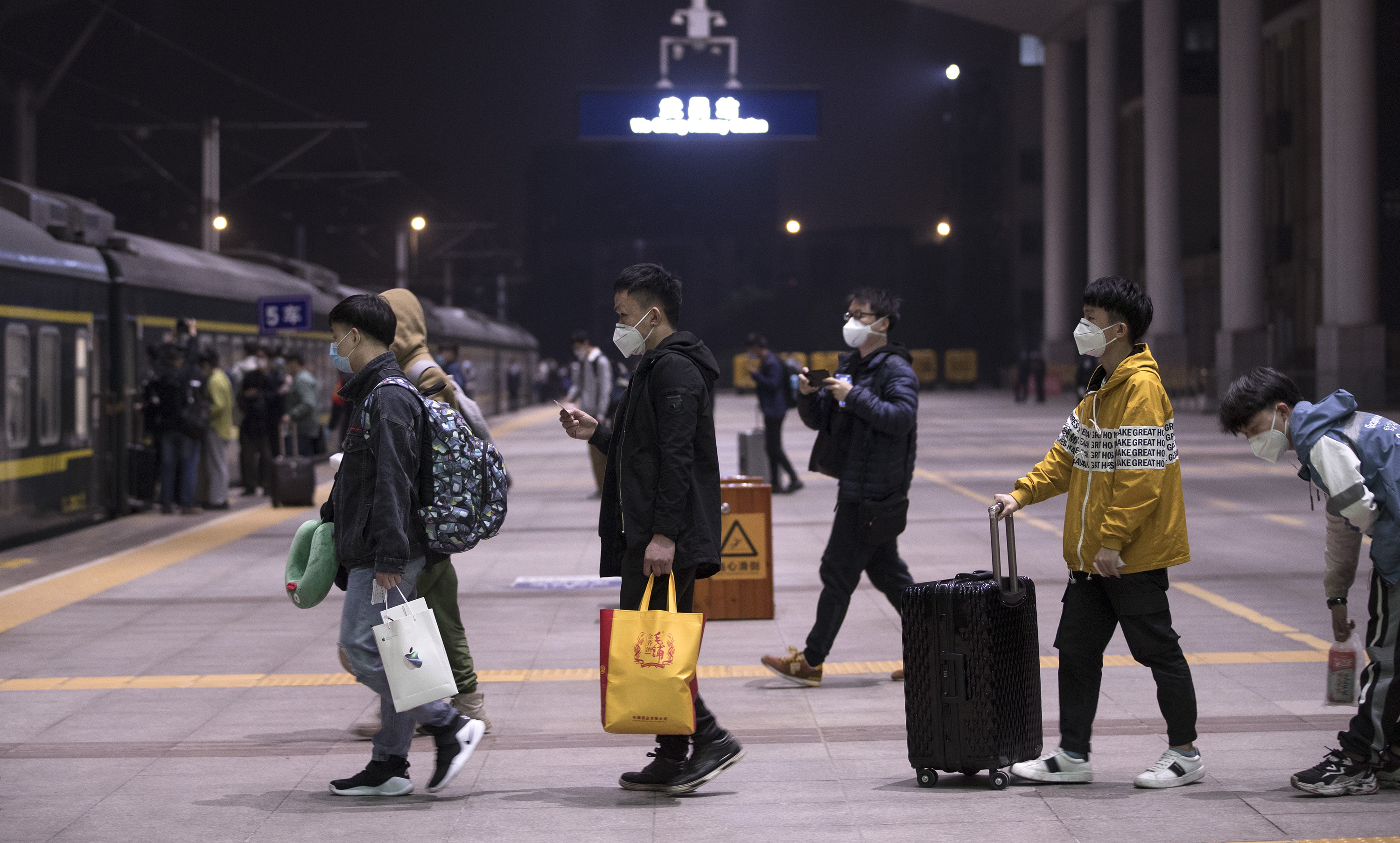
Passengers prepare to board train K81 at the Wuchang Railway Station in Wuhan, central China's Hubei Province, April 8, 2020. (Xinhua/Fei Maohua)
A woman surnamed Liu drove with her family from Shenzhen to visit her mother, a pancreatic cancer patient. Their plan to spend the Spring Festival in Enshi City, 500 km away from Wuhan, was also disrupted by the sudden closure of the city.
"We had to settle down in Wuhan and my mother is still waiting to be hospitalized. My child will take the college entrance examination this year but has been unable to attend school, and I can't go back to work," said Liu, who is desperate for the lifting of travel restrictions.
Though Hubei reported cases of COVID-19 in late December last year, few had expected the outbreak would eventually develop into a global pandemic.
As of 2 a.m. CEST April 8, the pathogen had caused over 72,000 fatalities and infected more than 1.28 million people around the world, data from the World Health Organization (WHO) showed.
In Wuhan alone, as of April 7 Beijing Time, 50,008 people were infected and 2,572 died, accounting for 61 percent and 77 percent of the national total, respectively.
LIFE-AND-DEATH BATTLE
A week before the lockdown, Yin Rui (pseudonym) went home and enjoyed a big dinner with 20 relatives. She noticed that her mother had a bit of cough that day.
"My mom worked as a kitchen warehouse manager at a hotel and often had contact with people from the seafood market, one of the first places where the virus was detected," the 23-year-old Wuhan resident recalled.
None of them thought much of it, assuming it was just a common cold. They gathered again for dinner the next day, and her mother later developed a fever.
"We thought the coronavirus was still remote," said Yin, who returned to her own home after dinner.
Her mother's condition deteriorated on Jan. 22 and her grandfather also became feverish before long. CT scans showed they both had white lungs and should be immediately hospitalized. White lung formation is generally a sign that the lungs have been invaded by inflammation.
But they still needed to test for nucleic acid before a diagnosis could be made.
The test kits, however, were in serious shortage in Wuhan back then.
"They arrived in batches. We failed to get one in the first batch so we waited for another round. Finally, at around 9:30 a.m. on Feb. 2, we were told that the testing was ready," said Yin. Her father rode a battery car and carried them to a hotel for nucleic acid testing.
Though already critically ill, Yin's mother still waited for more than an hour to be tested. Unfortunately, she soon suffered from severe dyspnea and passed away at home at around 1 p.m. that day.
"The ambulance came half an hour after she died as there were too many patients. My younger brother told us the grievous news on the phone and my head was buzzing," she said.
"We had no time for mourning and immediately contacted the funeral home for cremation. They were also very busy and didn't come until night," said Yin.
"I rushed home in the afternoon and my family wouldn't let me go upstairs to our home. So I had to stand far away and watched my mother be carried away. I saw at least five bodies in the vehicle," she said.
Her grandmother also showed COVID-19 symptoms in the coming days. Meanwhile, all the family members were put under quarantine as Wuhan began a combing of its over 3,300 communities and villages to ensure every confirmed or suspected patient was located and attended to.
To ensure the timely admission of patients, two emergency hospitals with a total of 2,600 beds were built from scratch in Wuhan within about two weeks, and 16 temporary hospitals were converted from gyms and exhibition centers to add 13,000 beds. Nucleic acid testing capacity in Wuhan reached 24,000 people a day thanks to the support from the rest of the country. Testing and treatment were made free according to a policy rolled out by the central government.
Over 30,000 medical staff, including elite medical groups, poured into the city from across the country. At the peak of the fight, one in 10 intensive care medics in China were working in Wuhan.
"The nearby hospital had some spare beds after the emergency hospitals were built, my grandpa was soon admitted and later transferred to a major city hospital. My grandma was treated at an emergency hospital," said Yin. "Both of them have been discharged and are safe at home after a fortnight quarantine at a hotel."
In Wuhan's life-and-death battle against COVID-19, there were so many stories of heartbreak echoing the experience of Yin's family.
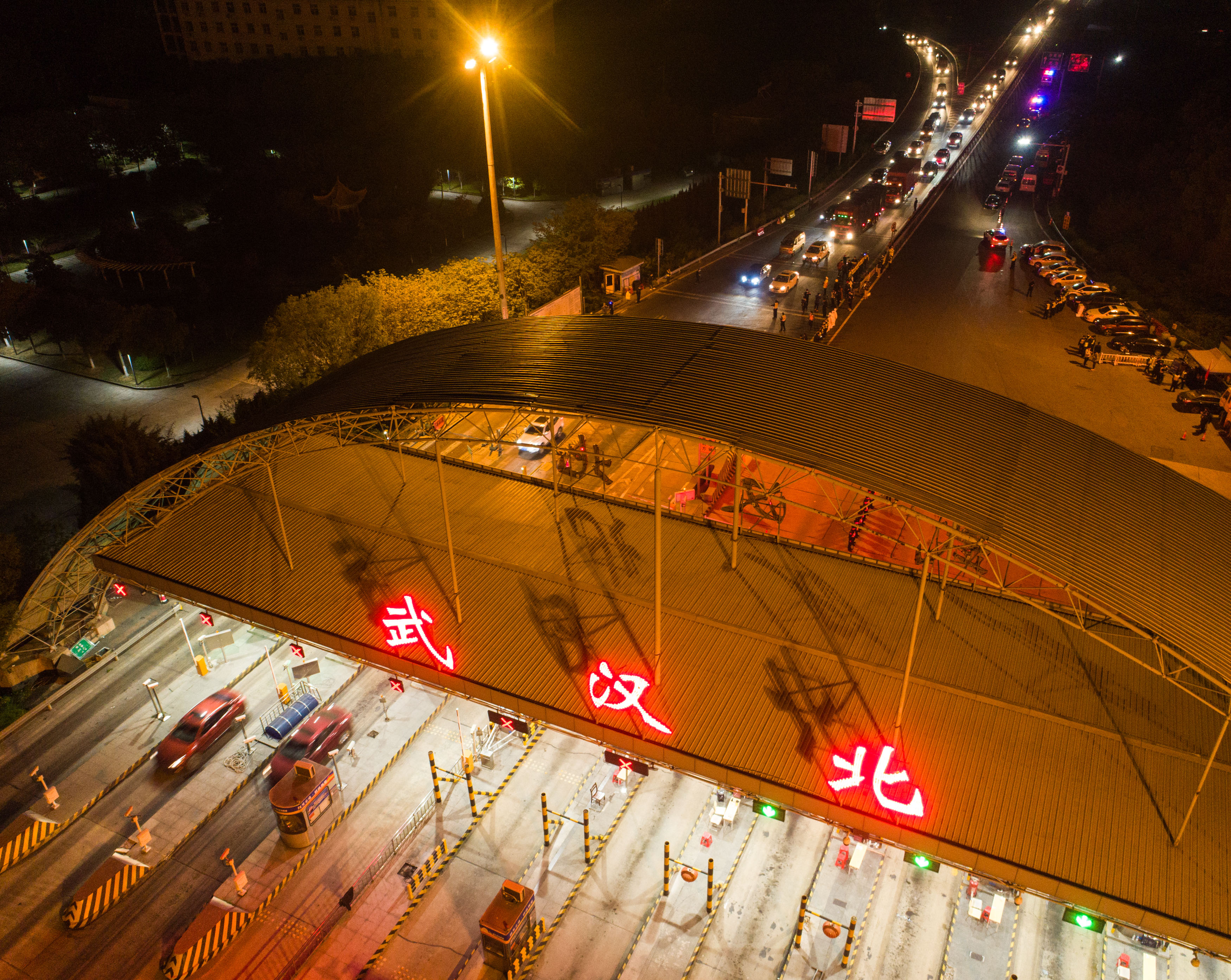
Aerial photo taken on April 8, 2020 shows cars passing an expressway toll station in northern Wuhan, central China's Hubei Province. (Xinhua/Xiao Yijiu)
"No respiratory department in Wuhan had a spare bed at the height of the epidemic," said Hu Ke, a respiratory physician at Hubei Provincial People's Hospital. "The eastern wing of the hospital I work at was completely vacated during the Lunar New Year to treat COVID-19 patients, but it was still far from enough. Even the ophthalmology building was fully occupied."
For more than a month, Hu had been on duty and slept less than five hours a day. As a member of the provincial COVID-19 treatment team, he has been tied up with group consultations and visits at fever clinics and wards of major hospitals in Wuhan.
Hu said the novel coronavirus is very cunning and highly contagious. Treatment has been difficult as the condition of patients changes rapidly.
"The patient may develop white lungs in three to five days while being treated with drugs and injection," said Hu. "The most difficult part is -- there are no specific drugs. Even remdesivir, oseltamivir and arbidol have not been fully proved to be effective."
Losses are tremendous. Besides ordinary people, more than 3,000 doctors and nurses were infected, with at least 14 deaths. The deceased also include workers, farmers, drivers, government officials, police officers, scientists, university professors, athletes, entrepreneurs and more.
On Feb. 11, Wuhan further tightened personnel movement by demanding all residential communities be closed. Each family could only have one person go out every three days, and supermarkets no longer served individual customers.
Residents in Wuhan therefore depended on food delivery and centralized procurement services from the community for food and daily commodities.
Chen Zhiyong, a 35-year-old deliveryman, was celebrating the Spring Festival with family in Xinzhou, a suburban district in Wuhan when he learned of the outbreak.
Hearing that there was a shortage of drivers to transport medical supplies and commodities, he immediately drove back.
"It took me two days to get the pass. I was quite emotional on the way back," he said. "I just wanted to do something."
"It was quite scary to watch the death toll climbing every day, so I barely spoke at work," said Chen. "Now that the temporary hospitals are closed and the number of newly confirmed cases dropped to a few, I feel greatly relieved and chitchat a little while keeping a safe distance."
Instant noodles and bread have been his lunch for the past two months. "It's a race against time every day," said Chen. Since Feb. 23, his main task has become purchasing food and daily necessities for residents.
"I miss my family very much, but I want to be a role model for my child," he said.
Many people got through this period by keeping diaries, reading books, and greeting friends and family via video calls. Isolated lovers hugged each other virtually and many promised to tie the knot after the epidemic.
The children are taught online. Supplies bearing the message "Stay strong, Wuhan!" were pouring in from all over the world to cheer locals up.
Left-behind pets were taken care of by neighbors. In a video that went viral on TikTok, a woman was seen extending a clothesline pole dangling a sausage out of her window toward a golden retriever in the opposite apartment. The dog, lying on the window sill, seemed weak and hungry and quickly gobbled the sausage.
A pregnant cat named Le Le, whose owners -- a family of seven -- were all infected and hospitalized, was home alone for 40 days with food and water left by her owners. She even gave birth to four kittens when the whole family returned safely back.
To quell people's fears and address problems concerning their psychological health, Wuhan opened two 24-hour hotlines on the lockdown day, with services offered by the Zhongnan Hospital of Wuhan University and the Hubei Psychological Consultant Association. Such services have been provided nationwide and also for overseas Chinese by volunteer doctors.
VIRUS SEALED, HOPE ARISES
Sealing off a megacity has never been seen in modern Chinese history. "The closure of the city is an unprecedented move and it has been proved to be completely correct," said Zhang Jinnong, director of the emergency department at the Union Hospital affiliated to Tongji Medical College of Huazhong University of Science and Technology.
"The closure came at the Spring Festival travel peak, when billions of trips were expected to be made," said Zhang. "But to be honest, I didn't expect such a big decision."
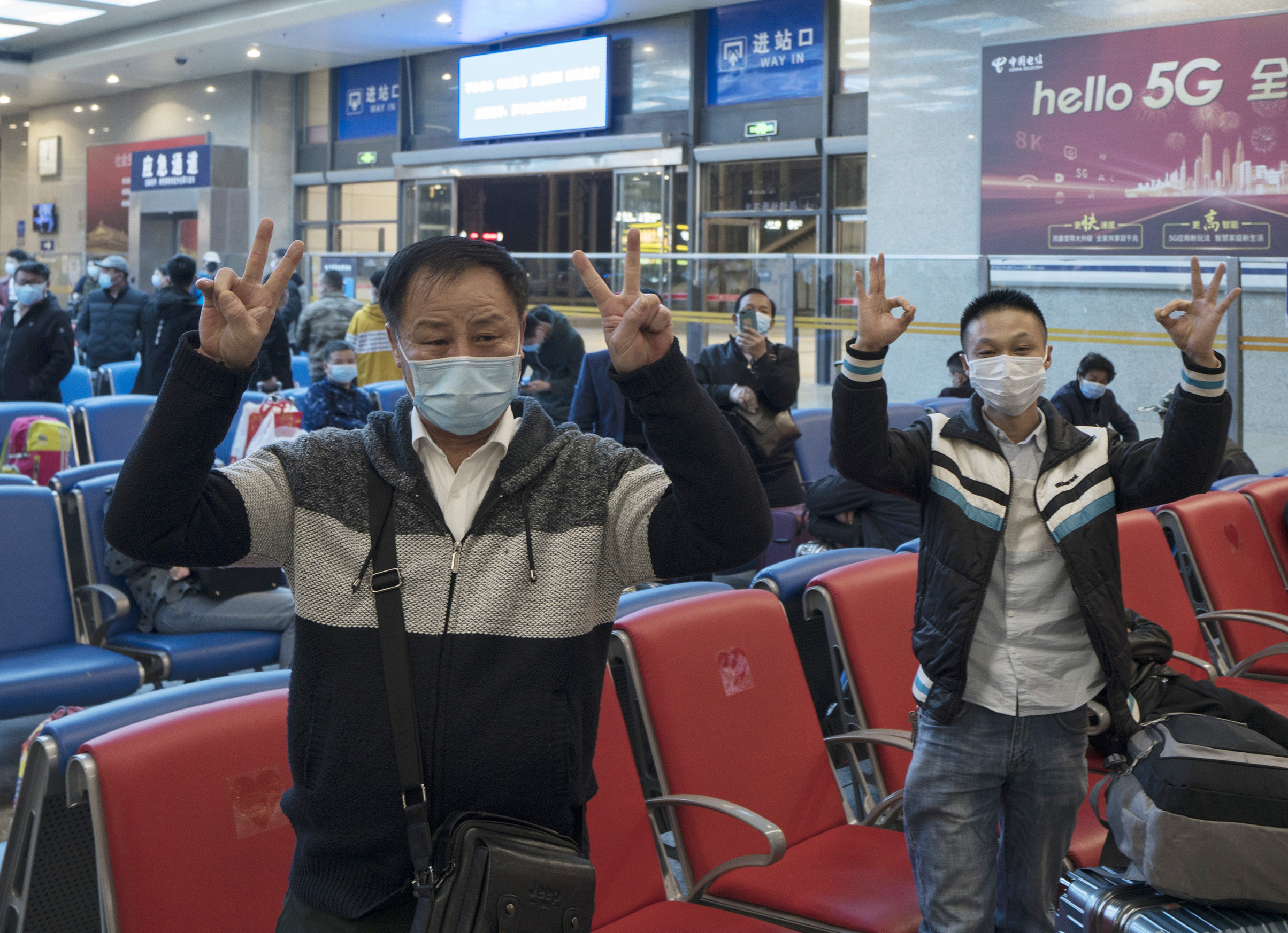
Passengers cheer up for Wuhan while waiting to take train K81 at the Wuchang Railway Station in Wuhan, central China's Hubei Province, late April 7, 2020. (Xinhua/Fei Maohua)
On Dec. 31, the Wuhan municipal health commission announced the city had discovered 27 pneumonia cases with unknown causes.
China shared the genome sequences of the new virus with WHO on Jan. 12 after identifying the pathogen on Jan. 7.
On Jan. 20, renowned respiratory expert Zhong Nanshan in a media interview confirmed human-to-human transmission of the coronavirus and infections among medical personnel.
"Infection of medics is obvious evidence of human-to-human transmission," said Zhang, who was also infected on the job but has fully recovered.
"The trend of the epidemic has testified that the closure of Wuhan has bought time for the whole country and the rest of the world as well," he said.
In fact, almost all cities in Hubei have taken similar measures to prohibit or restrict inter-city movements, due to the severity of the epidemic. And the whole country has been strictly implementing quarantine measures despite the recent improvement in the epidemic situation.
The tough measures taken by China to stop the spread of the new coronavirus in the first 50 days of the epidemic have bought other cities across the country valuable time to prepare and install their own restrictions, according to the paper published in late March in the journal Science by researchers from China, the United States and Britain.
"Our analysis suggests that without the Wuhan travel ban and the national emergency response there would have been more than 700,000 confirmed COVID-19 cases outside of Wuhan by that date," said Oxford fellow Christopher Dye, co-author of the paper in a press release.
Official data showed by Feb. 19, there were 56,303 confirmed cases on the Chinese mainland. "China's control measures appear to have worked by successfully breaking the chain of transmission -- preventing contact between infectious and susceptible people," said Dye.
The Chinese mainland began to see a drop in the number of COVID-19 patients on Feb. 18, after the number of recovered patients surged and new cases declined. By late February, the virus had withdrawn from most regions in the country, with only single-digit daily increases of infections in areas outside Wuhan.
On March 11, the daily increase of locally transmitted infections dropped to single digits for the first time on the Chinese mainland, where the virus has caused a total of 81,802 infections and 3,333 fatalities as of midnight April 7.
Wuhan has only reported three newly confirmed cases since March 18, and no newly confirmed cases in other parts of Hubei have been reported since March 5.
Behind the downward trends were a raft of strong measures taken by the Chinese government, including canceling mass events, closing scenic attractions, suspending long-distance buses and asking hundreds of millions of Chinese to stay indoors to break the transmission chain.
"All these measures have been implemented very well," said Hu Ke. "The fact that not one of the more than 42,000 medical staff assisting Hubei was infected is also a miracle on account of adequate protective measures. This is an experience that can be learned in other countries and regions," said Hu.
SCARRED CITY RECOVERING
While the lockdown took citizens in Wuhan almost off guard -- announced only hours in advance, preparation for reopening began half a month ago. On March 25, Hubei Province lifted outbound travel restrictions in all areas except Wuhan.
A day later, Wuhan resumed the first 117 bus routes, or 30 percent of the city's total bus transport capacity, in a move to prudently prepare for getting normal life back on track.
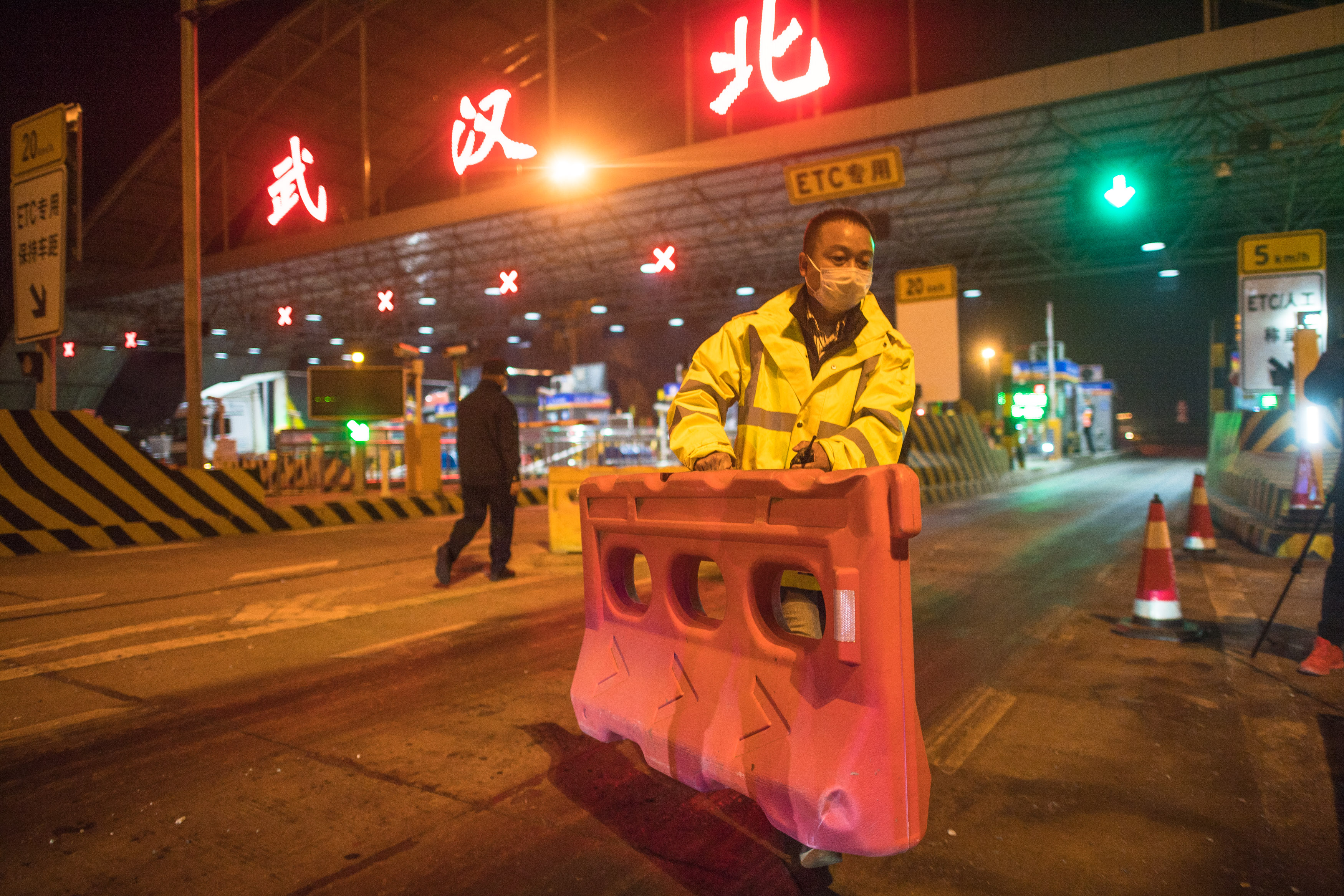
A staff member removes a barricade at an expressway toll station in northern Wuhan, central China's Hubei Province, April 8, 2020. (Xinhua/Xiao Yijiu)
As more work resumption picks up steam, Wuhan has seen an increase of nearly 400,000 vehicles on roads in the past half month, and 1.8 million are expected to hit the road after Wednesday, according to the city's traffic police.
The long-lost traffic jams, ferry sirens, and stream of masked customers lining up outside "reganmian" (or hot dry noodles) stores to grab their favorite breakfast have indicated that Wuhan is ready to reopen, in a cautious manner.
But the city does not expect an immediate return to business-as-usual, and there are still strict measures in place to avoid a second wave of infection. Everyone is aware that the lifting does not come easy and Wuhan is far from out of the woods.
Yin Rui returned home on March 29. "I dared not go home because there are so many memories. Mom and I were so close," she said. "I went to my room -- where Mom passed away -- and sat in silence. Grandma came in and hugged me, we wept for a long time. We talked a lot that night," she said.
China paused in silence to mourn the lives lost to the coronavirus outbreak on April 4, the country's Tomb-sweeping Day to remember the deceased.
People in Wuhan bowed in the square, police took off their caps, and the national flag flew at half-mast, when the nation, with its 1.4 billion people, came to a halt for a full three minutes from 10:00 to 10:03 a.m.
Ren's family burned paper money for her mother on that night, an old tradition to pay tribute to the dead. "My grandparents were watching the live broadcast on TV during the national mourning, and I was in a daze," she said.
"My mom's ashes are still stored in the cemetery. We have been hiding the truth from my (maternal) grandma, who has a heart problem," she said.
Yin planned to tell her grandmother what had happened and hold a funeral for her mother soon after the lifting of traffic bans.
"I miss Mom every day. I have her phone with me and charge it daily so I can check her photos at any time. But so far I still don't dare to listen to her voice messages," said Yin.
She hoped to study abroad when all things are properly settled. "I think Mom would also support my decision, she always had an inquiring mind. She would be very happy seeing me fulfill her dream."
(Video reporters: Yang Zhigang, Xu Yang, Ma Yuanchi, Dong Bohan, Hao Xiaojiang, Yu Guoqing, Wang Siban, Rao Rao, Pan Zhiwei, Fang Yadong, Xiao Zhengqiang, Liu Chang; Video editor: Liu Ruoshi)



